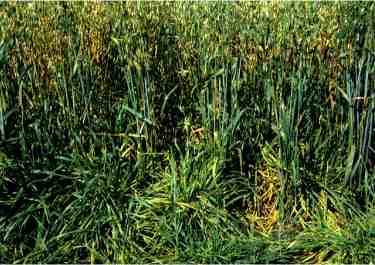| | Winter cereals are an excellent way to add flexibility to a livestock operation by providing supplemental or emergency pasture for grazing livestock. These crops produce sufficient growth throughout the growing season to provide summer pasture. They can also be used to extend the grazing season in the fall, spring or both the fall and the spring. Winter cereals give producers the flexibility to add pastures quickly when needed.
Winter cereals seeded in the spring tend to be very productive during the summer, depending on soil moisture and fertility. They require a vernalization period to produce seed and when spring seeded, these crops remain vegetative and produce only leaves. This makes them very easy to manage for grazing. Winter cereals are more productive under intensive grazing management systems than when grazed continually. The quality of the winter cereals is high and can easily be 20% protein and 75% digestibility. Research at the Lacombe Research Centre as well as the Western Beef Development Centre at Saskatoon have shown livestock gains to be very high when grazing winter cereals. These crops not only make ideal summer pastures but they maintain their growth and quality well into the fall, making them ideal for extending the fall grazing period. The most common winter cereals for grazing are fall rye, winter triticale and winter wheat.
Intercropping spring cereals with winter cereals provides a crop that can be harvested for silage or greenfeed and allowed to regrow for fall grazing. The high quality of the leaf material from the winter cereals increases the quality of the silage or greenfeed. When allowed to regrow the winter cereals provide high quality pasture that can be grazed until covered with snow. Winter triticale and fall rye are more productive during the fall than winter wheat. These crops are capable of withstanding frosts and still maintain their green color and quality.
When grown together the silage crops may suffer some yield loss, but the silage and pasture yields together produce more forage per acre than either one grown separately. The regrowth from the intercrop yielded higher than the spring cereal seeded alone.
Winter cereals make an excellent pasture crop and can be used not only through the growing season, but also throughout the year to extend the grazing season. Growing winter cereals for pasture is generally more expensive than utilizing perennials for pasture, however, winter cereals provide producers with the ability to graze crops when they would traditionally be feeding stored feeds. This reduces harvesting, handling, feeding and manure disposal costs. Winter cereals give the producer more flexibility within their livestock operation.

Arvid Aasen, Forage & Pasture Agronomist,
Western Forage/Beef Group / AAFRD, Lacombe |
|